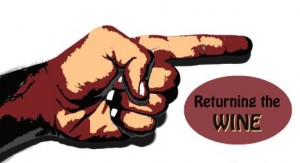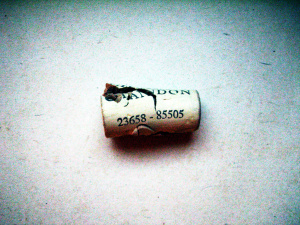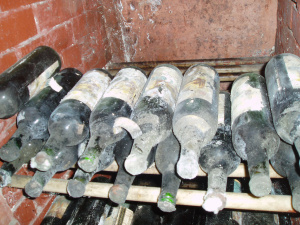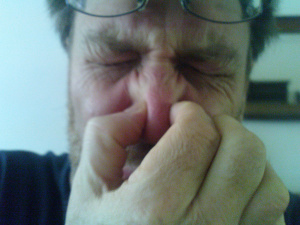When should you return the wine in a restaurant?

The question, “what do you do when a guest wants to return the wine”, came up in a recent twitter conversation on #WineChat a few weeks ago. The real question was, “what do you do when a guest says the wine is corked?” My answer was simple, take it back. “What if the wine is not corked?” The answer again was, “Take it back”. This led me to think more about the many times I am at the table doing the wine presentation and anticipating the guests reaction. I know there are times when the guest tastes the wine and I see that they are not too pleased, but hold back from saying anything. There are also times when the guest already has it in his mind to return the wine. I’d like to share my opinion of when a guest should return the wine.
There are two typical scenarios. The first is the guest looks over the list and selects his/her own wine without help of the server or sommelier. The other is when the server or sommelier suggest a wine to the guest.
Lets take the first scenario, the guest picks his/her own wine. In this situation it is assumed that the guest knows what he/she is looking for and picks a wine which he/she is familiar. The guest tastes the wine and the wine is not as fruity, not as sweet, not as dry, not as tannic; it’s not what they expected. The guest then decides to return it. That is a No-No. If the wine does not have a fault, (something we will address later) then he/she should keep the wine. The wine should only be returned is the wine is faulty. Just because the wine doesn’t taste as you thought it might, you do not have the right to return it. If you would like that right, then buy insurance and ask for a recommendation.
Now lets take scenario number two, purchasing insurance, where the server or sommelier recommends a wine based on the guests preference. The guest says I want a dry red wine, with soft tannins and fruity. The server then recommends a young Cabernet from Howell Mt because he remembers the sommelier praising it. However, upon tasting the wine, it’s obviously not soft and fruity. At this point, the guest has every right to return the wine. The server did not recommend a wine which met the guest’s expectations. The wine might be delicious, but it was not what they had ordered. It’s almost like ordering white fish and getting Salmon. If you are unsure of what to order or unfamiliar with the list, ask the server or sommelier. If you end up getting an ignorant server, then feel free and return the wine. But even better, you might just get what you wanted.
As a sommelier, regardless of which scenario occurs, I take back the wine. We are in the business to make friends, not to put people in uncompromising situations. Remember, there are a lot of restaurants out there, and retaining returning guests ultimately falls on how you treat them.
One day I had a server come to me and tell me that one of their tables wanted to see me because they were unsure if the wine was good or bad. The guest had ordered the Sadie Family Profadder Grenache. They chose it themselves. I came to the table and the gentleman asked, “Can you please taste this I want to see if you like it? I think it might be bad, it is too acidic.”
I looked at the man and said, “Sir, I’d be happy to taste it but I agree with your description, the wine is acidic. Why don’t you let me suggest another wine.”
For those not familiar with Sadie family, these are wines from South Africa that are all about terroir and minimal manipulation, the wines have high acid. The gentleman insisted that I taste it. I told him that I knew I was going to like it, but it was probably not what he was looking for. I granted his wish and tasted the wine, absolutely delicious! It had a light color, beautiful red fruits and backed by mouth-watering acidity.
I looked at the gentleman and said, “this is absolutely delicious, however, you are right it has very high acidity, why don’t you let me take this back. I will surely enjoy it later tonight and I will recommend another wine for you. I brought him out a bottle of David Phinney’s D66, a Grenache from France which is deep and dark in color with big fruit and on the complete opposite spectrum of the Sadie Family. The man, loved it. He was pleased that we allowed him to return the wine and I was happy that I had a bottle of Sadie to savor later that evening.
This short antidote leads me to the next topic, wine faults. The gentleman should not have returned the wine since it was his choice. He should have asked for a recommendation. He believed the wine was bad. However, the wine did not have a fault. In this day in age when so many wines are beginning to taste the same, anything that is a bit different (the Sadie Family wines) is now construed as a wine fault. That is so sad. Because the wine smells like earth or soil, that is not a fault. If the wine has high acidity, that is not a fault. Everyone seems to think that wine should taste like California Cabernet. They want their Pinots to taste like Cab, they see Grenache and expect it to taste like Cab, and if it does not, then it is a fault. Well as we all know that is just absurd. What if all our fish tasted like Salmon?
So what are wine faults? Here are a few very common wine faults which call for a guest to return the wine.
- Cork taint or better known as a wine containing TCA. TCA is a chemical used in fungicides and sometimes transferred from the cork to the wine. The wine smells like wet cardboard or damp dog. The aroma is pretty distinguishable. Although the wine will not hurt you if you drink it, it is unpleasant to smell. Two things I’d like to clarify, smelling the cork will not tell you the wine is infected, so smell the wine and not the cork.
 Secondly, if the cork breaks, it does not mean the wine is corked. Silly as it sounds, I have had many people complain that the wine is corked because the cork broke. Corks break for various reasons, old corks, bad wine keys, server error, cheap corks etc…before you send it back because of a broken cork, taste the wine. If your wine has cork taint then you should return the wine. Order another of the same bottle, it is rare that the case is infected, it usually varies from bottle to bottle.
Secondly, if the cork breaks, it does not mean the wine is corked. Silly as it sounds, I have had many people complain that the wine is corked because the cork broke. Corks break for various reasons, old corks, bad wine keys, server error, cheap corks etc…before you send it back because of a broken cork, taste the wine. If your wine has cork taint then you should return the wine. Order another of the same bottle, it is rare that the case is infected, it usually varies from bottle to bottle.
- Another fault is oxidation. Oxidation occurs when the wine has been exposed to oxygen or too much heat while in the bottle. This is usually a result of a faulty enclosure or poor storage which has dried out the cork and allowed air to seep in. The wine will smell of vinegar.
 Oxidation might also affect the color of the wine. The wine may turn amber or brown when it becomes too oxidized. When trying the wine at the restaurant, smell it. If the wine smells like vinegar or sherry-like and it is not sherry it is most likely oxidized. Some aged wines will have these qualities, but it does not mean the wine is oxidized. If ordering an older vintage you should expect oxidation, but it should be palatable. Younger wines which are tasting like vinegar are faulty, and should be returned. In this case ask for a second bottle, it might have just been a faulty cork.
Oxidation might also affect the color of the wine. The wine may turn amber or brown when it becomes too oxidized. When trying the wine at the restaurant, smell it. If the wine smells like vinegar or sherry-like and it is not sherry it is most likely oxidized. Some aged wines will have these qualities, but it does not mean the wine is oxidized. If ordering an older vintage you should expect oxidation, but it should be palatable. Younger wines which are tasting like vinegar are faulty, and should be returned. In this case ask for a second bottle, it might have just been a faulty cork.
- There are a whole slew of other faults that might affect the wine. They range from the wine making process to storage. I am not going to touch upon each fault in this post.
 However, if your wine smells of rotten eggs it is most likely faulty, return the wine. If it smells of burnt tires, cooked cole slaw or band-aid then it is most likely faulty, return the wine. Some times you might get gamey, barnyard or moldy aromas, it might be faulty. See if they blow off, if the wine doesn’t shoe fruit then it is most likely faulty. Many times great wines have these aromas. Let it sit, aerate it and if they continue to outshine the fruit, then return the wine.
However, if your wine smells of rotten eggs it is most likely faulty, return the wine. If it smells of burnt tires, cooked cole slaw or band-aid then it is most likely faulty, return the wine. Some times you might get gamey, barnyard or moldy aromas, it might be faulty. See if they blow off, if the wine doesn’t shoe fruit then it is most likely faulty. Many times great wines have these aromas. Let it sit, aerate it and if they continue to outshine the fruit, then return the wine.
If you are unsure if your wine is faulty and you want a second opinion, call the sommelier over and have them taste it. The sommelier will either confirm or deny the wine is faulty. Most people don’t want to call the sommelier over, for fear that he/she says the wine is perfectly fine and you look like a fool in front of your guests. A good sommelier will never make you feel foolish. Instead of returning the wine and ordering another of the same bottle, or of a new wine, do call the sommelier. Some wines do have faults and depending on the fault the sommelier will either tell you to order another of the same bottle or pick a new wine. If the wine is not faulty, but it’s just not your style, then order a different bottle. If the wine is corked or oxidized, let them bring you another of the same bottle, many times it is bottle variation. Do not feel intimidated to call the sommelier over, he is your friend.
Don’t be intimidated in returning the wine. If you are unsure ask for a second opinion. Asking your guests for an opinion will usually lead to them confirming your suspicion. Your guests don’t want to make you look bad or disagree and risk the chance that they look bad. Get assistance from the sommelier. If the wine is just not what you wanted, then feel free to return the wine. I can promise you that the wine will not go to waste.









3 Comments
wine news fall
Wine consumption has been linked to everything
from improved cataract conditions to heart disease reduction. After having a look around the store I settled on a California Zinfandel.
Excess alcohol consumption can damage liver and can cause a wide range of liver problems depending on the amount of alcohol consumed.
Landon Davis
I serve at an upscale restaurant and recently sold a 25 yo top-notch barolo to a valued customer. The customer noted sherry notes in the bouquet (as did i) and a flabby, very short finish upon first tasting it. He worried that it might be too far off to drink but would wait for it to breath in the decanter.
10 minutes later, he stated that it just wasn’t coming around and requested it removed from the table and replaced with a different wine. Now, the customer said he would cover the cost, but the owner felt uncomfortable with that when I informed him of the situation. The wine was indeed not where it should’ve been, but it wasn’t truly cooked… Let’s say, it was “lightly marinated,” if you will.
Who should pay in this case? With a wine that old, there is no distributor to help shoulder the loss, and $1k is a huge loss for a restaurant, even a high-end one. But, the wine was indeed not what the customer had a right to anticipate. I would appreciate your thoughts… Thanks
Maurice
That is a tough question. Was the problem the wine or how it was stored? The restaurant may have only had it for a few years, who knows who had it before hand. It could also be that the wine was too old, poor vintages from modern producers may not age as well. Unfortunately I think this lies on the restaurant. It is a gamble getting into the old vintage market, especially on premise. For this reason if the wine buyer is going to buy older vintages, it is best that they do research on the vintage and producer. Not all wine is meant to age, and that goes for Barolos as well. You really can’t pass that on to the guest. it is the price we pay for doing business. What a bummer!